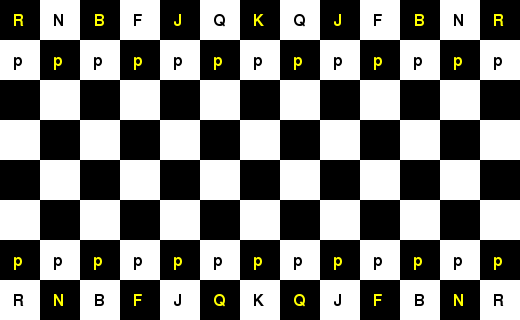
PHI Chess is a Chess variant played on a 13x8 board.
PHI (Φ) is shorthand for the golden ratio (1.618034...). Thirteen divided by eight is 1.625 - a decent approximation of Phi. A thirteen by eight board is a golden rectangle, long considered to be the most attractive to human eyes.
There are two armies: White and Black. Each army begins with twenty-six units:
These units begin the game in the position shown below:

Kings sit on their own color - in the diagram above, White is on the bottom.
Horizontal rows of squares are called ranks; vertical columns of squares are called files. The top and bottom ranks are called the King's Ranks.
The object of the game is to capture the enemy king.
White moves first. White and Black take turns moving one piece at a time.
Different pieces move in different ways (explained below). A piece may end it's move on an empty square or a square occupied by an enemy. A piece that ends its move on a square occupied by an enemy captures that enemy - the captured piece is removed from the board and the attacker occupies its square.
A player may pass, moving no piece, giving the enemy two turns in a row.
Pawns
Pawns are the weakest units. They can only move a single step, and only in the direction of the enemy King's Rank. They cannot capture with a forward move, however; pawns capture one square diagonally forward. Pawns are the only unit that move and capture in different ways.
In the diagram below, the '^' represents a square to which the (White) pawn can move without capture; the 'x' represents a square to which the pawn can move and capture if occupied by an enemy.

Pawns that reach the enemy King's Rank are promoted to a more powerful piece (anything other than a King or Pawn).
The Rook
The Rook can move any number of squares up, down, left, or right of it's current position. It's movement is blocked by other pieces in the way (unless it captures an enemy, at which point it stops in the enemy's square).
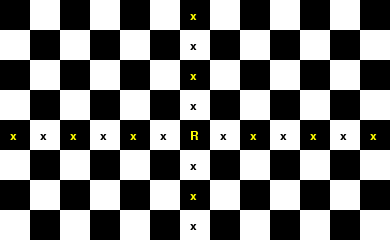
The Knight
The Knight moves in an L-shape: it moves one square up, down, left, or right, and then makes a ninety-degree turn and moves two squares in another direction. It's movement is not blocked by other units; it leaps over them.

The Bishop
The Bishop can move any number of squares along diagonal lines extending from the corners of its current square. It's movement is blocked by other pieces in the way (unless it captures an enemy, at which point it stops in the enemy's square).
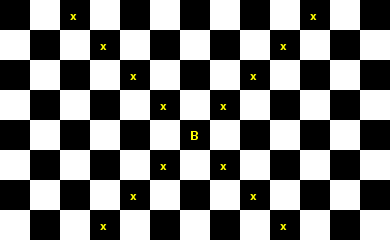
The Fool
The Fool can move as a Bishop or a Knight. It leaps when it moves as a Knight, but not when it moves as a Bishop.
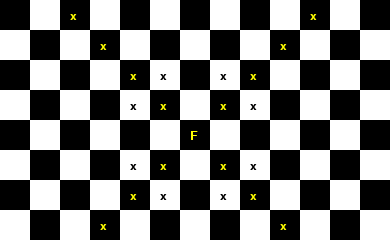
The Jack
The Jack can move as a Rook or a Knight. It leaps when it moves as a Knight, but not when it moves as a Rook.

The Queen
The Queen can move as a Rook or a Bishop.

The King
The King is the most important piece. Capture the enemy king to win the game.
The King may take a single step in any direction.

Piece Values
The following are rough estimates for the value of each unit. True values depend on position and player.
| Unit | Value |
|---|---|
| Pawn | 1 |
| Knight | 3 |
| Bishop | 3 |
| Rook | 5 |
| Fool | 7 |
| Jack | 9 |
| Queen | 9 |
A player who captures the enemy king wins the game.
A player who captures all enemy units except the king wins the game.
If thirty moves pass without a pawn move or a capture, both players sum the values of all their remaining pieces and pawns. The player with the higher sum is the winner. In the case of a tie, the game is a draw.
If both players pass twice in succession, the game is a draw.
Cool features of the 13x8 board and the chosen setup:
The board is a golden rectangle.
The odd number of files means that the King sits directly in the middle. His minions, arrayed to the left and right, form a mirror image of pleasant symmetry.
The King sits on his own color.
The board has light and dark sides. On the light side, both the King's square and the corner squares are white; on the dark side, they are black.
Both Bishops are bound to the color of their army. This means that White is more powerful on white squares, Black is more powerful on black squares, and each army's Bishops can defend one another.
Each army has six pieces that move like Rooks, six that move like Knights, and six that move like Bishops.
All pawns are well-defended in the starting position, especially those in front of the King. The following diagram shows the number of times each pawn is defended:
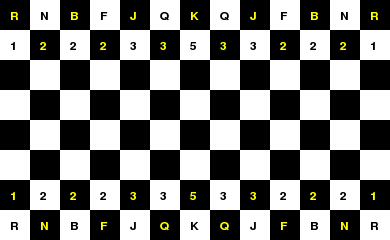
The golden what?
Click here for an explanation of the Golden Ratio.
Visit goldennumber.net for all kinds of interesting trivia.
What about castling, en passant, etc?
Some rules from classic Chess are abandoned in Phi Chess, primarily those that were ad hoc solutions to a problem.
Pawns have no initial two-step move. This rule was introduced to speed up the tempo of classic Chess; PhiChess doesn't seem to suffer for it's loss. Each side has more room to develop without fear of an instant pawn assault, yet games remain relatively quick.
There is no rule for castling. This rule was introduced to protect the King after Bishops and Queens became much more powerful. The Phi Chess King begins the game in a strong position; castling seems unnecessary, perhaps even dangerous.
There is no check or checkmate. An attacker need not warn the enemy king of danger. Removing this rule makes the game less stodgy and more accessible to casual players.
There is no stalemate. Since either side may opt to pass their turn, draws occur only if neither opponent can maneuver the enemy king into a capture. Being trapped in a position with no legal moves is no benefit.